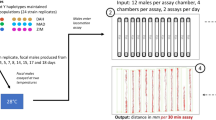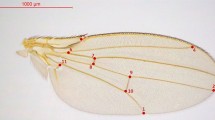Abstract
To characterize the morphological variation in a natural population of Drosophila mediopunctata, males were collected on three occasions at a single locality. From each wild-caught male 14 body measures were taken and the karyotype for inversions on chromosomes X and II was determined. Through a principal components analysis, two sources of variation, identified as size and shape, accounted for approximately 80 and 6 per cent of the total morphological variability, respectively. The shape component was determined primarily by variations in the position of the wing second longitudinal vein. Differences between collections were detected both for size and shape. An altitudinal cline was observed in respect of wing shape, although altitude explained only a small part of the shape variation. Size and shape were affected by chromosome II inversions. However, in respect of size, no direct differences were detected between karyotypes but a significant interaction between collecting date and karyotype was found. This suggests that karyotypes might differ in their norms of reaction in the field.
Similar content being viewed by others
Article PDF
References
Alonso, A, and Munoz, A. 1984. Biometrie characterization of some wing measurements in Drosophila melanogaster. Drosoph Inf Serv, 60, 47–48.
Arnold, J. 1981. Statistics of natural populations. I: Estimating an allele probability in cryptic fathers with a fixed number of offspring. Biometrics, 37, 495–504.
Barth, R. 1957. A fauna do Parque Nacional do Itatiaia. Bol Pq Nac Itatiaia, no. 6, 150 pp. Serviço Florestal, Ministério da Agricultura, Resende, Rio de Janeiro.
Bookstein, F L, Chernoff, B, Elder, R L, Humphries, J M, Smith, G R, and Strauss, R E. 1985. Morphometries in Evolutionary Biology. Academy of Natural Sciences, Philadelphia, PA.
Cavicchi, S, Giorgi, G, and Mochi, M. 1978. Investigation on early divergence between populations of Drosophila melanogaster kept at different temperatures. Genetica, 48, 81–87.
Coyne, J A, and Beecham, E. 1987. Heritability of two morphological characters within and among natural populations of Drosophila melanogaster. Genetics, 117, 727–737.
David, J, and Bocquet, C. 1975. Similarities and differences in latitudinal adaptation of two Drosophila sibling species. Nature, 257, 588–590.
David, J R, Moreteau, B, Gauthier, J P, Pétavy, G, Tockel, A, and Imasheva, A G. 1994. Reaction norms of size characters in relation to growth temperature in Drosophila melanogaster. an isofemale lines analysis. Génét Sél Évol, 26, 229–251.
Etges, W J. 1989. Chromosomal influences on life-history variation along an altitudinal transect in Drosophila robusta. Am Nat, 133, 83–110.
García-Vázquez, E, and Sánchez-Refusta, F. 1989. Chromosomal polymorphism and extra bristles of Drosophila melanogaster. joint variation under selection in isofemale lines. Genetica, 78, 91–96.
Hasson, E, Fanara, J J, Rodriguez, C, Vilardi, J C, Reig, O A, and Fontdevila, A. 1992. The evolutionary history of Drosophila buzzatii. XXIV. Second chromosome inversions have different average effects on thorax length. Heredity, 68, 557–563.
Imasheva, A G, Bubli, O A, and Lazebny, O E. 1994. Variation in wing length in Eurasian natural populations of Drosophila melanogaster. Heredity, 72, 508–514.
Klaczko, L B, and Bitner-Mathe, B C. 1990. On the edge of a wing. Nature, 346, 231.
Krimbas, C B, and Powell, J R. 1992. Drosophila Inversion Polymorphism. CRC Press, Boca Raton, FL.
Lewontin, R C. 1974. The analysis of variance and the analysis of causes. Am J Hum Genet, 26, 400–411.
Marcus, L F. 1990. Traditional morphometries. In: Rohlf, F. J. and Bookstein, F. L. (eds) Proc Michigan Morphometric Wortehop. Special Publication Number 2, pp. 77–122. The University of Michigan Museum of Zoology, Ann Arbor, MI.
Matzke, M M, and Druger, M. 1976. Evolutionary divergence between two populations of Drosophila pseudoobscura. Evolutional, 597–602.
Maynard Smith, J, Burian, R, Kauffman, S, Alberch, P, Campbell, J, Goodwin, B, Lande, R, Raup, D, and Wolpert, L. 1985. Developmental constraints and evolution. Q Rev Biol, 60, 265–287.
Misra, R K. 1966. Vectorial analysis for genetic clines in body dimensions in populations of Drosophila subobscura Coll. and a comparison with those of Drosophila robusta Sturt. Biometrics, 22, 469–487.
Misra, R K, and Reeve, E C R. 1964. Clines in body dimensions in populations of Drosophila subobscura. Genet Res, 5, 240–256.
Peixoto, A A, and Klaczko, L B. 1988. Polimorfismos de inversões cromossômicas em Drosophila mediopunctata III. Variacões sazonal e microgeográ;fica. Cienc Cult, 40 (Suppl.), 770.
Peixoto, A A, and Klaczko, L B. 1991. Linkage disequilibrium analysis of chromosomal inversion polymorphisms of Drosophila. Genetics, 129, 773–777.
Pfriem, P. 1983. Latitudinal variation in wing size in Drosophila subobscura and its dependence on polygenes of chromosome O. Genetica, 61, 221–232.
Prevosti, A. 1955. Geographical variability in quantitative traits in populations of Drosophila subobscura. Cold Spring Harb Symp Quant Biol, XX, 294–299
Price, T, and Langen, T. 1992. Evolution of correlated characters. Trends Ecol Evol, 7, 307–310.
Prout, T, and Barker, J S F. 1989. Ecological aspects of the heritability of body size in Drosophila buzzatii. Genetics, 123, 803–813.
Ruiz, A, Santos, M, Barbadilla, A, Daz, J E, Hasson, E, and Fontdevila, A. 1991. Genetic variance for body size in a natural population of Drosophila buzzatii. Genetics, 128, 739–750.
Santos, M, Fowler, K, and Partridge, L. 1994. Gene-environment interaction for body size and larval density in Drosophila melanogaster. an investigation of effects on development time, thorax length and adult sex ratio. Heredity, 72, 515–521.
SAS Institute. 1988. SAS/STAT User's Guide, Release 6.03 Edition. SAS Institute, Cary, NC.
Sesardic, N. 1993. Heritability and causality. Phil Sci, 60, 396–418.
Sokoloff, A. 1965. Geographic variation of quantitative characters in populations of Drosophila pseudoobscura. Evolution, 19, 300–310.
Sperlich, D, and Pfriem, P. 1986. Chromosomal polymorphism in natural and experimental populations. In: Ash-burner, M., Carson, H. L. and Thompson, J. N., Jr. (eds) The Genetics and Biology of Drosophila, 3e, pp. 257–309. Academic Press, London.
Stalker, H D, and Carson, H L. 1947. Morphological variation in natural populations of Drosophila robusta Sturtevant. Evolution, 1, 237–248.
Stalker, H D, and Carson, H L. 1948. An altitudinal transect of Drosophila robusta Sturtevant. Evolution, 2, 295–305.
Stalker, H D, and Carson, H L. 1949. Seasonal variation in the morphology of Drosophila robusta. Evolution, 3, 330–343.
Tachida, H, and Mukai, T. 1985. The genetic structure of natural populations of Drosophila melanogaster. XIX. Genotype-environment interaction in viability. Genetics, 111, 43–55.
Tantawy, A O. 1964. Studies on natural populations of Drosophila. III. Morphological and genetic differences of wing length in Drosophila melanogaster and D. simulans in relation to season. Evolution, 18, 560–570.
Van Delden, W, and Kamping, A. 1991. Changes in relative fitness with temperature among second chromosome arrangements in Drosophila melanogaster. Genetics, 127, 507–514.
Acknowledgements
We are grateful to Luis Lima Neto who provided us with the digitizing pad software, Dr Sergio Reis for invaluable suggestions during the development of this work and help with computation facilities and Dr Richard Strauss for insightful comments on the shearing method. We also thank Dr Antonio Bernardo de Carvalho, Dr Carlos R. Vilela and anonymous reviewers for critical comments of this manuscript. Mrs Clea Knauer da Silva gave us technical assistance. The Nücleo de Computacäo Gräfica da COPPE and NUTES from Universidade Federal do Rio de Janeiro provided facilities to perform part of this work. These investigations were supported by: Conselho Nacional de Desenvolvimento Cientifico e Tecnologico (CNPq); Financiadora de Estudos e Projetos (FINEP); Coordenacäo de Aperfeicoamento de Pessoal de Ensino Superior (CAPES) and Fundacäo de Amparo ä Pesquisa do Rio de Janeiro (FAPERJ).
Author information
Authors and Affiliations
Rights and permissions
About this article
Cite this article
Bitner-Mathé, B., Peixoto, A. & Klaczko, L. Morphological variation in a natural population of Drosophila mediopunctata: altitudinal cline, temporal changes and influence of chromosome inversions. Heredity 75, 54–61 (1995). https://doi.org/10.1038/hdy.1995.103
Received:
Issue date:
DOI: https://doi.org/10.1038/hdy.1995.103
Keywords
This article is cited by
-
A review of the taxonomy and biology of Triatominae subspecies (Hemiptera: Reduviidae)
Parasitology Research (2022)
-
Sex-specific plasticity and the nutritional geometry of insulin-signaling gene expression in Drosophila melanogaster
EvoDevo (2021)
-
Genetic variability and phenotypic plasticity of metric thoracic traits in an invasive drosophilid in America
Genetica (2015)
-
Cellular basis of morphological variation and temperature-related plasticity in Drosophila melanogaster strains with divergent wing shapes
Genetica (2014)
-
Evolution of the male genitalia: morphological variation of the aedeagi in a natural population of Drosophila mediopunctata
Genetica (2009)



